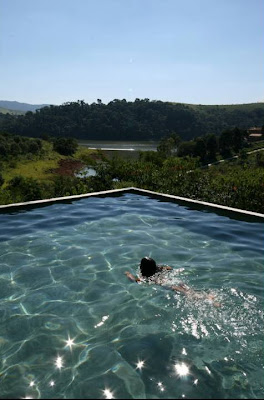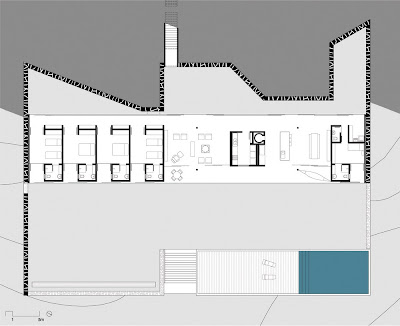Joanopolis House - UNA Arquitetos
Great work from this brazilian architects. It blends with the landscape, while being fully opened to the amazing views of its surrounding.
The house was designed for friends who used to visit Carambó, a farm two kilometers away where we built a pavilion in 2002. The region is located at the foot of the one thousand feet high Mantiqueira Mountain, on the border of São Paulo and Minas Gerais states.
The stone walls were built with the use of local techniques with rocks collected locally, originating a continuous but not straight line, for self-sustention, that forms the framing wall. Thus, three interrelated courtyards are formed outside the inner rooms of the house, bedrooms, living room and services. The walls broaden out and draw back as if in a movement giving room to the internal spaces.
Out from the street there is only the view of the white tower which holds the whole infra structure (kitchen, chimneys, water tank and heaters) and a 8×40 meters horizontal ruler comes up as the roof garden. This solution guarantees efficient thermal inertia in places with a wide range of temperatures changes between day and night.
A first plateau, where cars can be parked, comes in an intermediate level between the street and the house. This level takes you up to the roof garden or downstairs through a little tunnel leading to the entrance gateway that reaches the courtyard outside from the living room.
The suggested usage would be the mingling of many people in simultaneous activities - a party house. The conviviality spaces are gathered by the fireplace and ovens, split by the volume of the kitchen.
During the day these ambiences open up completely, giving place to a vast porch, and by night they can be closed up keeping the transparency. The glass sliding doors are withdrawn two meters from the facade, heading mostly to the north, allowing a vast view, which meets the dazzling distant outlook, and to the south opening to the courtyards. Wooden sliding panels were also designed for the bedrooms, in order to darken its interior.
The characteristics of the materials were respected. The molded concrete is structured in modulated spans of 4m, regardless its length. Moreover, the specifications and details were premises to the cost saving construction process.
The house opens up to a second grass-plateau leveled with the pool. Located at the edge, it pleases the eyes with visual continuity between its waters and the lake far in the distance. The construction of the pool and its solarium, holds underneath a pool table room, a storage and the pool equipment, which opens up to the third plateau.
Construction is landscape, geography, setting and history that melt away as an object.
Architects: Una Arquitetos
Location: Sao Paulo, Brazil
Project Team: Cristiane Muniz, Fábio Valentim, Fernanda Barbara & Fernando Viégas
Collaborators: Ana Paula de Castro, Jimmy Efrén Liendo Terán, José Carlos Silveira Júnior, Maria Cristina Motta, Miguel Muralha & Sílio Almeida
Contractor: Construtora Lomar
Structure: stec do brasil
Landscape: soma arquitetos
Site Area: 4.383 sqm
Constructed Area: 434 sqm
Project year: 2005
Construction year: 2008
Photographs: Bebete Viégas
The house was designed for friends who used to visit Carambó, a farm two kilometers away where we built a pavilion in 2002. The region is located at the foot of the one thousand feet high Mantiqueira Mountain, on the border of São Paulo and Minas Gerais states.
The stone walls were built with the use of local techniques with rocks collected locally, originating a continuous but not straight line, for self-sustention, that forms the framing wall. Thus, three interrelated courtyards are formed outside the inner rooms of the house, bedrooms, living room and services. The walls broaden out and draw back as if in a movement giving room to the internal spaces.
Out from the street there is only the view of the white tower which holds the whole infra structure (kitchen, chimneys, water tank and heaters) and a 8×40 meters horizontal ruler comes up as the roof garden. This solution guarantees efficient thermal inertia in places with a wide range of temperatures changes between day and night.
A first plateau, where cars can be parked, comes in an intermediate level between the street and the house. This level takes you up to the roof garden or downstairs through a little tunnel leading to the entrance gateway that reaches the courtyard outside from the living room.
The suggested usage would be the mingling of many people in simultaneous activities - a party house. The conviviality spaces are gathered by the fireplace and ovens, split by the volume of the kitchen.
During the day these ambiences open up completely, giving place to a vast porch, and by night they can be closed up keeping the transparency. The glass sliding doors are withdrawn two meters from the facade, heading mostly to the north, allowing a vast view, which meets the dazzling distant outlook, and to the south opening to the courtyards. Wooden sliding panels were also designed for the bedrooms, in order to darken its interior.
The characteristics of the materials were respected. The molded concrete is structured in modulated spans of 4m, regardless its length. Moreover, the specifications and details were premises to the cost saving construction process.
The house opens up to a second grass-plateau leveled with the pool. Located at the edge, it pleases the eyes with visual continuity between its waters and the lake far in the distance. The construction of the pool and its solarium, holds underneath a pool table room, a storage and the pool equipment, which opens up to the third plateau.
Construction is landscape, geography, setting and history that melt away as an object.
Architects: Una Arquitetos
Location: Sao Paulo, Brazil
Project Team: Cristiane Muniz, Fábio Valentim, Fernanda Barbara & Fernando Viégas
Collaborators: Ana Paula de Castro, Jimmy Efrén Liendo Terán, José Carlos Silveira Júnior, Maria Cristina Motta, Miguel Muralha & Sílio Almeida
Contractor: Construtora Lomar
Structure: stec do brasil
Landscape: soma arquitetos
Site Area: 4.383 sqm
Constructed Area: 434 sqm
Project year: 2005
Construction year: 2008
Photographs: Bebete Viégas

































































Post a Comment